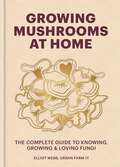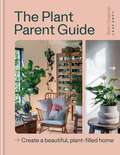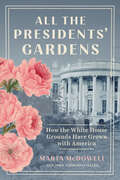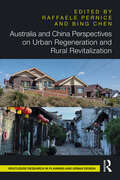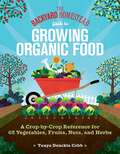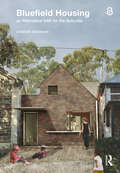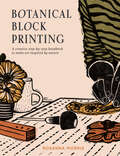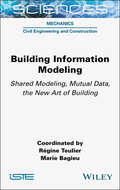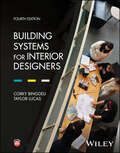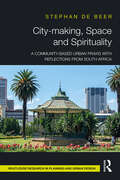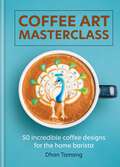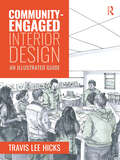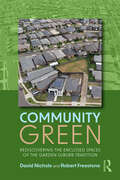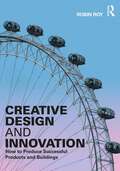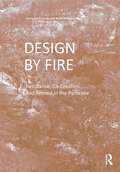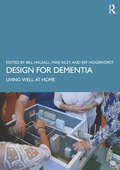- Table View
- List View
Growing Mushrooms at Home: The Complete Guide to Knowing, Growing and Loving Fungi
by Elliot WebbEverything you need to know to start growing mushrooms at home!Looking for something quick and easy to grow, that doesn't take up much space, and offers numerous health benefits? Then mushrooms are the perfect choice! Growing Mushrooms at Home will take you through all the basics, from key equipment and step-by-step growing guides all the way to how to turn your harvest into teas, coffees and tinctures. These guides can be used for many varieties - including shiitake, lion's mane, wine cap and oyster - and multiple different growing situations, from buckets and bags to outdoor beds and logs.As well as revealing the essential growing know-how, the book explores our long and complex human history with mushrooms and the fascinating ways fungi continues to shape our world. From ancient Aztec rituals and underground tree communication networks to ground-breaking new medicines and organic pesticides, Growing Mushrooms at Home uncovers the weird and wonderful world of mushrooms, and everything they have to offer.
The Plant Parent Guide: Create a beautiful, plant-filled home
by Beth ChapmanDid you know we spend an average of 90% of our time indoors? With the air-purifying, mind-calming, stress-relieving and productivity-boosting power of houseplants well established, it is time to transform your home with plants.Created by leading houseplant brand Leaf Envy, The Plant Parent Guide is here to reveal the incredible world of houseplants, but also teach you to select, style and care for them in the best way to suit your space.Upgrade your home with perfectly placed greenery by following the bespoke styling guides for every room, from shaded bedrooms to steamy bathrooms. Whether you're looking for the perfect Zoom backdrop or an oasis of calm in a busy kitchen, there are plenty of tips and tricks for choosing the best plants to suit your light, upkeep and styling requirements.Easy-to-follow care guides make becoming a plant parent pro simple, with advice for every season to ensure your plants flourish year-round. For houseplant newbies there are recommendations for the species hardest to kill, while for the already green-fingered there are ideas for more unusual plants to introduce, and instructions for mastering the art of propagation. With The Plant Parent Guide, any home can become a beautiful and thriving plant-filled space.Photography by Taran Wilkhu.
All the Presidents' Gardens: How the White House Grounds Have Grown with America
by Marta McDowellThis New York Times bestseller shares the rich history of the White House grounds, revealing how the story of the garden is also the story of America. The 18-acres surrounding the White House have been an unwitting witness to history—kings and queens have dined there, bills and treaties have been signed, and presidents have landed and retreated. Throughout it all, the grounds have remained not only beautiful, but also a powerful reflection of American trends. In All the Presidents' Gardens bestselling author Marta McDowell tells the untold history of the White House grounds with historical and contemporary photographs, vintage seeds catalogs, and rare glimpses into Presidential pastimes. History buffs will revel in the fascinating tidbits about Lincoln&’s goats, Ike's putting green, Jackie's iconic roses, Amy Carter's tree house, and Trump's controversial renovations. Gardeners will enjoy the information on the plants whose favor has come and gone over the years and the gardeners who have been responsible for it all. As one head gardener put it, &“What&’s great about the job is that our trees, our plants, our shrubs, know nothing about politics.&”
Australia and China Perspectives on Urban Regeneration and Rural Revitalization (Routledge Research in Planning and Urban Design)
by Raffaele Pernice Bing ChenThis edited volume reviews important contemporary issues through relevant case studies and research in China and Australia, such as the challenges posed by climate change, the development of eco-urban design, research on sustainable habitats and the relationship between ecology, green architecture and city regeneration, as well as, in general, the future of the city in the new millennium.The authors represent a broad selection of international experts, young scholars and established academics who discuss themes related to urban–rural destruction and economic and spatial regeneration techniques, the sustainable reconversion of natural landscapes and eco-urban design in the context of the current evolution of architectural and urbanism practice. The book aims to explain the conditions in which the contemporary debate about urban regeneration and rural revitalisation has developed in Australia and China, presented by different theoretical and methodological perspectives. It also provides a multifaceted and critical analysis of relevant case studies and urban experiences in Australia and China, focusing on environmental disruption, resized urban interventions and the need for more efficient and sustainable forms of regeneration and urban renewal practice in urban–rural contexts.This book will be an invaluable resource for architects, planners, architectural and urban historians, geographers, and scholars interested in modern Australian and Chinese architecture and urbanism.
Australia and China Perspectives on Urban Regeneration and Rural Revitalization (Routledge Research in Planning and Urban Design)
This edited volume reviews important contemporary issues through relevant case studies and research in China and Australia, such as the challenges posed by climate change, the development of eco-urban design, research on sustainable habitats and the relationship between ecology, green architecture and city regeneration, as well as, in general, the future of the city in the new millennium.The authors represent a broad selection of international experts, young scholars and established academics who discuss themes related to urban–rural destruction and economic and spatial regeneration techniques, the sustainable reconversion of natural landscapes and eco-urban design in the context of the current evolution of architectural and urbanism practice. The book aims to explain the conditions in which the contemporary debate about urban regeneration and rural revitalisation has developed in Australia and China, presented by different theoretical and methodological perspectives. It also provides a multifaceted and critical analysis of relevant case studies and urban experiences in Australia and China, focusing on environmental disruption, resized urban interventions and the need for more efficient and sustainable forms of regeneration and urban renewal practice in urban–rural contexts.This book will be an invaluable resource for architects, planners, architectural and urban historians, geographers, and scholars interested in modern Australian and Chinese architecture and urbanism.
The Backyard Homestead Guide to Growing Organic Food: A Crop-by-Crop Reference for 62 Vegetables, Fruits, Nuts, and Herbs
by Tanya Denckla CobbThis essential guide to growing a bountiful food garden includes detailed seed-starting, growing, and harvesting information for 62 vegetables, fruits, and herbs, a complete companion-planting guide, and organic pest-control handbook. The latest addition to Storey's bestselling Backyard Homestead series, The Backyard Homestead Guide to Growing Organic Food is a one-stop reference for all the key information food gardeners need to grow a healthy, bountiful garden. Author Tanya Denckla Cobb presents key information based on extensive research and years of experience, including when to start seeds for each type of crop (and at what temperature), how far apart to space seedlings, how to tell when a crop is ready to harvest, and notes on preservation. The book features a comprehensive companion planting guide and an in-depth review of the most effective organic pest control practices, including recipes for how to make your own pest deterrent sprays.
Bluefield Housing as Alternative Infill for the Suburbs
by Damian MadiganSuburbanised cities share a common dilemma: how to transition to more densely populated and socially connected urban systems while retaining low-rise character, avoiding gentrification, and opening neighbourhoods to more diverse housing choices. Bluefield Housing offers a new land definition and co-located infill model addressing these concerns, through describing and deploying the types of ad-hoc modifications that have been undertaken in the suburbs for decades. Extending green-, brown-, and greyfield definitions, it provides a necessary middle ground between the ‘do nothing’ attitude of suburban preservation and the ‘do everything’ approach of knock-down-rebuild regeneration.An adjunct to ‘missing middle’ and subdivision densification models, with a focus on co-locating homes on small lots, Bluefield Housing presents a unified design approach to suburban infill: retrofitting original houses, retaining and enhancing landscape and urban tree canopies, and delivering additional homes as low-rise additions and backyard homes suited to the increasingly complex make-up of our households.Extensively illustrated by the author with engaging architectural design studies, Damian Madigan describes how existing quirks of suburban housing can prompt new forms of infill, explains why a new suburban densification model is not only necessary but can be made desirable for varied stakeholders, and charts a path towards the types of statutory and market triggers required to make bluefield housing achievable. Using Australian housing as an example but addressing universal concerns around neighbourhood character, demographic needs, housing diversity, dwelling flexibility, and landscape amenity, Bluefield Housing offers innovative suburban infill ideas for policy makers, planners, architects, researchers and students of housing and design studies, and for those with a stake in the future of the suburbs.The Open Access version of this book, available at www.taylorfrancis.com, has been made available under a Creative Commons Attribution-Non Commercial-No Derivatives (CC-BY-NC-ND) 4.0 license.
Bluefield Housing as Alternative Infill for the Suburbs
by Damian MadiganSuburbanised cities share a common dilemma: how to transition to more densely populated and socially connected urban systems while retaining low-rise character, avoiding gentrification, and opening neighbourhoods to more diverse housing choices. Bluefield Housing offers a new land definition and co-located infill model addressing these concerns, through describing and deploying the types of ad-hoc modifications that have been undertaken in the suburbs for decades. Extending green-, brown-, and greyfield definitions, it provides a necessary middle ground between the ‘do nothing’ attitude of suburban preservation and the ‘do everything’ approach of knock-down-rebuild regeneration.An adjunct to ‘missing middle’ and subdivision densification models, with a focus on co-locating homes on small lots, Bluefield Housing presents a unified design approach to suburban infill: retrofitting original houses, retaining and enhancing landscape and urban tree canopies, and delivering additional homes as low-rise additions and backyard homes suited to the increasingly complex make-up of our households.Extensively illustrated by the author with engaging architectural design studies, Damian Madigan describes how existing quirks of suburban housing can prompt new forms of infill, explains why a new suburban densification model is not only necessary but can be made desirable for varied stakeholders, and charts a path towards the types of statutory and market triggers required to make bluefield housing achievable. Using Australian housing as an example but addressing universal concerns around neighbourhood character, demographic needs, housing diversity, dwelling flexibility, and landscape amenity, Bluefield Housing offers innovative suburban infill ideas for policy makers, planners, architects, researchers and students of housing and design studies, and for those with a stake in the future of the suburbs.The Open Access version of this book, available at www.taylorfrancis.com, has been made available under a Creative Commons Attribution-Non Commercial-No Derivatives (CC-BY-NC-ND) 4.0 license.
Botanical Block Printing: A Creative Step-by-step Handbook To Make Art Inspired By Nature
by Rosanna MorrisDiscover the world of botanical block printing through an approachable guide that unveils a plethora of practical techniques and processes. This guide invites you to create stunning prints inspired by the natural world, all crafted by your own hands.
Building Information Modeling: Shared Modeling, Mutual Data, the New Art of Building
by Marie Bagieu Régine TeulierThis book presents how Building Information Modeling (BIM) and the use of shared representation of built assets facilitate design, construction and operation processes (ISO 19650). The modeling of public works data disrupts the art of construction. Written by both academics and engineers who are heavily involved in the French research project Modélisation des INformations INteropérables pour les INfrastructues Durables (MINnD) as well as in international standardization projects, this book presents the challenges of BIM from theoretical and practical perspectives. It provides knowledge for evolving in an ecosystem of federated models and common data environments, which are the basis of the platforms and data spaces. BIM makes it possible to handle interoperability very concretely, using open standards, which lead to openBIM. The use of a platform allows for the merging of business software and for approaches such as a Geographic Information System (GIS) to be added to the processes. In organizations, BIM meets the life cycles of structures and circular economy. It is not only a technique that reshapes cooperation and trades around a digital twin but can also disrupt organizations and business models.
Building Information Modeling: Shared Modeling, Mutual Data, the New Art of Building
by Régine Teulier Marie BagieuThis book presents how Building Information Modeling (BIM) and the use of shared representation of built assets facilitate design, construction and operation processes (ISO 19650). The modeling of public works data disrupts the art of construction. Written by both academics and engineers who are heavily involved in the French research project Modélisation des INformations INteropérables pour les INfrastructues Durables (MINnD) as well as in international standardization projects, this book presents the challenges of BIM from theoretical and practical perspectives. It provides knowledge for evolving in an ecosystem of federated models and common data environments, which are the basis of the platforms and data spaces. BIM makes it possible to handle interoperability very concretely, using open standards, which lead to openBIM. The use of a platform allows for the merging of business software and for approaches such as a Geographic Information System (GIS) to be added to the processes. In organizations, BIM meets the life cycles of structures and circular economy. It is not only a technique that reshapes cooperation and trades around a digital twin but can also disrupt organizations and business models.
Building Systems for Interior Designers
by Corky Binggeli Taylor LucasBUILDING SYSTEMS FOR INTERIOR DESIGNERS Make design decisions informed by technical and structural knowledge with this essential guide Professional interior design demands more than simply an understanding of aesthetic and artistic considerations; it also requires a detailed understanding of building systems and their interactions. Design decisions must account for mechanical and electrical equipment, building components, and structural elements, all of which can potentially shape a designer’s work. Building Systems for Interior Designers has long stood as the key to understanding and evaluating these elements, particularly key building systems like HVAC and plumbing, and their impacts on interior design. This Fourth Edition is fully updated to fit the needs of the CIDA certified interior design program and the NCIDQ exam. The fourth edition of Building Systems for Interior Designers also includes: Updated information on sustainable and energy-efficient design Detailed coverage of topics including security concerns, fire safety, and designing secure spaces Classroom supplements including sample construction documents, chapter specific discussion questions, and more Building Systems for Interior Designers is ideal for students in interior design courses and new professionals studying for NCIDQ exams.
Building Systems for Interior Designers
by Corky Binggeli Taylor LucasBUILDING SYSTEMS FOR INTERIOR DESIGNERS Make design decisions informed by technical and structural knowledge with this essential guide Professional interior design demands more than simply an understanding of aesthetic and artistic considerations; it also requires a detailed understanding of building systems and their interactions. Design decisions must account for mechanical and electrical equipment, building components, and structural elements, all of which can potentially shape a designer’s work. Building Systems for Interior Designers has long stood as the key to understanding and evaluating these elements, particularly key building systems like HVAC and plumbing, and their impacts on interior design. This Fourth Edition is fully updated to fit the needs of the CIDA certified interior design program and the NCIDQ exam. The fourth edition of Building Systems for Interior Designers also includes: Updated information on sustainable and energy-efficient design Detailed coverage of topics including security concerns, fire safety, and designing secure spaces Classroom supplements including sample construction documents, chapter specific discussion questions, and more Building Systems for Interior Designers is ideal for students in interior design courses and new professionals studying for NCIDQ exams.
City-making, Space and Spirituality: A Community-Based Urban Praxis with Reflections from South Africa
by Stéphan de BeerThis book is about the soul of the city, embodied in its spaces and people. It traces dynamics in inner city neighbourhoods of South Africa’s post-apartheid capital, Pretoria. Viewing the city through its most vulnerable people and places, it recognizes that urban space is never neutral and shaped by competing value frameworks. The first part of the book invites planners, city-makers, and ordinary urban citizens, to consider a new self-understanding, reclaiming their agency in the city-making process. Through the metaphor of "becoming like children", planning practice is deconstructed and re-imagined. A praxis-based methodology is presented, cultivating four distinct moments of entering, reading, imagining and co-constructing the city. After deconstructing urban spaces and discourses, the second part of the book explores a concrete spirituality and ethic of urban space. It argues for a shift from planning as technocracy, to planning as immersed, participatory artistry: opening up to the "genius" of space, responsive to urban cries, and joining to construct new, soul-full spaces. Local communities and interconnected movements become embodiments of urban alternatives – through resistance and reconstruction; building on local assets; animating local reclamations; and weaving nets of hope that will span the entire city. Providing a concrete methodology for city-making that is rooted in a community-based urban praxis, this book will be of interest to urban planning researchers, professional planners and designers and also grass-root community developers or activists.
City-making, Space and Spirituality: A Community-Based Urban Praxis with Reflections from South Africa
by Stéphan de BeerThis book is about the soul of the city, embodied in its spaces and people. It traces dynamics in inner city neighbourhoods of South Africa’s post-apartheid capital, Pretoria. Viewing the city through its most vulnerable people and places, it recognizes that urban space is never neutral and shaped by competing value frameworks. The first part of the book invites planners, city-makers, and ordinary urban citizens, to consider a new self-understanding, reclaiming their agency in the city-making process. Through the metaphor of "becoming like children", planning practice is deconstructed and re-imagined. A praxis-based methodology is presented, cultivating four distinct moments of entering, reading, imagining and co-constructing the city. After deconstructing urban spaces and discourses, the second part of the book explores a concrete spirituality and ethic of urban space. It argues for a shift from planning as technocracy, to planning as immersed, participatory artistry: opening up to the "genius" of space, responsive to urban cries, and joining to construct new, soul-full spaces. Local communities and interconnected movements become embodiments of urban alternatives – through resistance and reconstruction; building on local assets; animating local reclamations; and weaving nets of hope that will span the entire city. Providing a concrete methodology for city-making that is rooted in a community-based urban praxis, this book will be of interest to urban planning researchers, professional planners and designers and also grass-root community developers or activists.
Coffee Art Masterclass: 50 incredible coffee designs for the home barista
by Dhan TamangTake your coffee art to the next level with 50 spectacular-yet-simple latte art designs to impress family and friends. From the comfort of your own kitchen you can recreate great paintings, pour and etch stunning natural wonders, iconic buildings and fantastical creatures. No special equipment is needed and once you've mastered the basics a world of incredible coffee art awaits you.Coffee Art Masterclass includes next-level latte designs that everyone can achieve.
Community-Engaged Interior Design: An Illustrated Guide
by Travis Lee HicksThis step-by-step guide takes the reader through each stage of the design process, from concept to completion, exploring practical methods of how to engage the community throughout interior architecture and design projects. This book argues that all design should be accomplished through a process of engagement, be it with community members, clients, or end users. The community-engaged designer welcomes participatory processes, mutually beneficial collaboration, and equitable inclusion in order to meet the needs and wants of diverse groups of people. Chapters cover the initial engagement of communities, marketing, and pre-design phases, translating research into a design scheme in development with the community, communicating designs, engaging community-based makers, craftspeople, product manufacturers, vendors, and distributors, constructing designs, and evaluating the end result. Finally, case studies of successful community-engaged design projects are presented and analyzed to demonstrate this approach in action. Learning objectives, chapter summaries, and exercises help to ease understanding and build design thinking and technical skills, equipping the reader with the tools to succeed as a community-engaged designer. Hicks distills years of experience teaching community-engaged design within this volume, which will be a valuable resource for all interior architecture and design students and practitioners.
Community-Engaged Interior Design: An Illustrated Guide
by Travis Lee HicksThis step-by-step guide takes the reader through each stage of the design process, from concept to completion, exploring practical methods of how to engage the community throughout interior architecture and design projects. This book argues that all design should be accomplished through a process of engagement, be it with community members, clients, or end users. The community-engaged designer welcomes participatory processes, mutually beneficial collaboration, and equitable inclusion in order to meet the needs and wants of diverse groups of people. Chapters cover the initial engagement of communities, marketing, and pre-design phases, translating research into a design scheme in development with the community, communicating designs, engaging community-based makers, craftspeople, product manufacturers, vendors, and distributors, constructing designs, and evaluating the end result. Finally, case studies of successful community-engaged design projects are presented and analyzed to demonstrate this approach in action. Learning objectives, chapter summaries, and exercises help to ease understanding and build design thinking and technical skills, equipping the reader with the tools to succeed as a community-engaged designer. Hicks distills years of experience teaching community-engaged design within this volume, which will be a valuable resource for all interior architecture and design students and practitioners.
Community Green: Rediscovering the Enclosed Spaces of the Garden Suburb Tradition
by David Nichols Robert FreestoneNeighbourhood open space ranks highly as a key component in suburban liveability assessments, originating from the development of urban planning as a profession and the proliferation of the garden suburb. Community Green uniquely connects the past, present and future of planning for small open spaces around the narrative of internal reserves.The distinctive planned spaces are typically enclosed on every side, hidden within residential blocks, serving as local pocket parks and reflecting the evolving values of community life from the garden city movement to contemporary new urbanism. This book resuscitates the enclosed, almost secretive reserve from history as a distinctive form of local open space whose problems and potentialities are relevant to many other green community spaces. In so doing, it opens up even wider connections between localism and globalism, the past and the future, and for connecting community initiatives to broader global challenges of cohesion, health, food, and climate change. This fully illustrated book charts the outcomes and implications of this evolution across several continents, injecting human stories of civic initiatives, struggles and triumphs along the way.Community Green will be of interest to a wide readership interested in studying, managing and improving the quality of all small open spaces in the urban landscape.
Community Green: Rediscovering the Enclosed Spaces of the Garden Suburb Tradition
by David Nichols Robert FreestoneNeighbourhood open space ranks highly as a key component in suburban liveability assessments, originating from the development of urban planning as a profession and the proliferation of the garden suburb. Community Green uniquely connects the past, present and future of planning for small open spaces around the narrative of internal reserves.The distinctive planned spaces are typically enclosed on every side, hidden within residential blocks, serving as local pocket parks and reflecting the evolving values of community life from the garden city movement to contemporary new urbanism. This book resuscitates the enclosed, almost secretive reserve from history as a distinctive form of local open space whose problems and potentialities are relevant to many other green community spaces. In so doing, it opens up even wider connections between localism and globalism, the past and the future, and for connecting community initiatives to broader global challenges of cohesion, health, food, and climate change. This fully illustrated book charts the outcomes and implications of this evolution across several continents, injecting human stories of civic initiatives, struggles and triumphs along the way.Community Green will be of interest to a wide readership interested in studying, managing and improving the quality of all small open spaces in the urban landscape.
Creative Design and Innovation: How to Produce Successful Products and Buildings
by Robin RoyUsing many real-world examples and cases, this book identifies key factors and processes that have contributed to the creation of successful new products, buildings, and innovations, or resulted in some failures. Such factors include the creativity of individuals and groups, their sources of inspiration, the processes of creative design and innovation, and the characteristics of the products, buildings, and innovations themselves. Much has been written about creativity and innovation, but what helps to foster creativity, enable creative ideas to be translated into practical designs, and ensure those new products or buildings succeed as innovations on the market or in use? This book discusses these elements through the author’s origination and analysis of examples and case studies ranging from the revolutionary innovation of the smartphone, through radical innovations in domestic appliances and sustainable housing, to creative designs of contemporary jewellery. The broad range of examples and cases include product and fashion design, filmmaking and fine art, as well as industrial design, engineering, and architecture, offering lessons for creatives, designers, and innovators from many subject backgrounds. Analysis of the different factors, successes, and failures are presented in text boxes throughout the book to allow readers to easily understand the key lessons from each example or case, with numerous colour visuals, diagrams, and charts for illustration. This book is a must-read for a broad audience interested in creativity, design, and innovation, including practitioners in design, engineering, architecture, and product management, and students and instructors of those subjects.
Creative Design and Innovation: How to Produce Successful Products and Buildings
by Robin RoyUsing many real-world examples and cases, this book identifies key factors and processes that have contributed to the creation of successful new products, buildings, and innovations, or resulted in some failures. Such factors include the creativity of individuals and groups, their sources of inspiration, the processes of creative design and innovation, and the characteristics of the products, buildings, and innovations themselves. Much has been written about creativity and innovation, but what helps to foster creativity, enable creative ideas to be translated into practical designs, and ensure those new products or buildings succeed as innovations on the market or in use? This book discusses these elements through the author’s origination and analysis of examples and case studies ranging from the revolutionary innovation of the smartphone, through radical innovations in domestic appliances and sustainable housing, to creative designs of contemporary jewellery. The broad range of examples and cases include product and fashion design, filmmaking and fine art, as well as industrial design, engineering, and architecture, offering lessons for creatives, designers, and innovators from many subject backgrounds. Analysis of the different factors, successes, and failures are presented in text boxes throughout the book to allow readers to easily understand the key lessons from each example or case, with numerous colour visuals, diagrams, and charts for illustration. This book is a must-read for a broad audience interested in creativity, design, and innovation, including practitioners in design, engineering, architecture, and product management, and students and instructors of those subjects.
Design by Fire: Resistance, Co-Creation and Retreat in the Pyrocene
by Emily Schlickman Brett MilliganAcross the world, the risks of wildfires are increasing and expanding. Due to past and current human actions, we dwell in the age of fire – the Pyrocene – and the many challenges and climate adaptation questions it provokes. Exploring our past and current relationships with fire, this book speculates on the pyro futures yet to be designed and cared for.Drawing upon fieldwork, mapping, drone imagery, and interviews, this publication curates 27 global design case studies within the vulnerable and dynamic wildland-urban interface and its adjacent wildlands. The book catalogs these examples into three approaches: those that resist the creative and transformative power of fire and forces of landscape change, those that embrace and utilize those forces, and those that intentionally try to retreat and minimize human intervention in fire-prone landscapes. Rather than serving as a book of neatly packaged solutions, it is a book of techniques to be considered, tested, and evaluated in a time of fire.
Design by Fire: Resistance, Co-Creation and Retreat in the Pyrocene
by Emily Schlickman Brett MilliganAcross the world, the risks of wildfires are increasing and expanding. Due to past and current human actions, we dwell in the age of fire – the Pyrocene – and the many challenges and climate adaptation questions it provokes. Exploring our past and current relationships with fire, this book speculates on the pyro futures yet to be designed and cared for.Drawing upon fieldwork, mapping, drone imagery, and interviews, this publication curates 27 global design case studies within the vulnerable and dynamic wildland-urban interface and its adjacent wildlands. The book catalogs these examples into three approaches: those that resist the creative and transformative power of fire and forces of landscape change, those that embrace and utilize those forces, and those that intentionally try to retreat and minimize human intervention in fire-prone landscapes. Rather than serving as a book of neatly packaged solutions, it is a book of techniques to be considered, tested, and evaluated in a time of fire.
Design for Dementia: Living Well at Home
by Bill Halsall Michael Riley Eef HogervorstDesign for Dementia is written by an interdisciplinary team of professionals and academics whose aim is to present lessons learnt from the Dementia Demonstration House at the Building Research Establishment’s Innovation Park. Known as Chris and Sally’s House, the project represents a unique opportunity to show in practice what can be done to assist people living with dementia to continue to live at home and as part of the community with as much independence as possible. This book presents evidence based practical design guidance backed up by over 15 combined years of research by experienced professional designers.Beginning with an introduction which provides the background to the global dementia epidemic to allow readers to gain a better understanding of the issues they must consider, the book then discusses how good design principles, planning and construction standards can be used to effectively respond to the dementia crisis. The detailed findings from research using Chris and Sally’s House are presented and discussed, along with practical examples and success stories ranging from simple design features to the more complex use of sensors and automated ventilation.The hope is that readers can apply the lessons learnt from Chris and Sally’s House to successfully integrate solutions into the design of new or refurbished housing for the elderly and also that the tools and insights shared will inform the wider context of good housing design, as well as the spectrum of constraints and design standards which often apply. This book is important reading for architects, designers, engineers and project managers, but also anyone with an interest in learning about practical solutions to aid those with dementia to live well at home.
